Top Gun: Maverick seduced audiences with powerful setpieces and magic moments that pay homage to the original 1986 film. Director Joseph Kosinski tells Screen about the shooting of four key sequences.
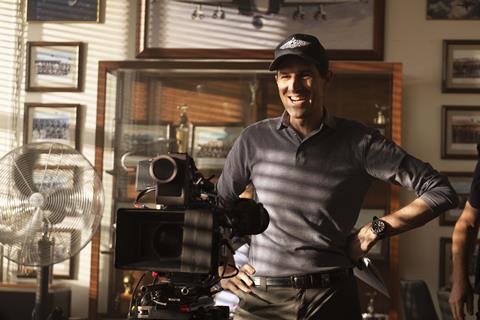
It may have been toppled as the biggest global box-office release of 2022 by Avatar: The Way Of Water, but Top Gun: Maverick can still lay claim to being the blockbuster of the year, a legacy sequel that proved cinema was alive and well and on a big screen.
Released 36 years after the original Top Gun, the belated sequel saw Tom Cruise reprise his career-defining role: a cocksure, rule-bending Navy fighter pilot who, three decades later, is still only a captain, albeit a much-decorated one. He continues to cause havoc, thumbing his nose at his superiors — here played by Ed Harris and Jon Hamm — while being the fastest man alive.
Maverick is ordered back to the US Navy’s elite flying school Top Gun by Val Kilmer’s Iceman, now an admiral, to teach 12 pilots how to fly an impossible mission to blow up an (unnamed) enemy’s uranium plant. Along the way he romances Jennifer Connelly’s single mum Penny while confronting his own obsolescence and his fractured relationship with Rooster (Miles Teller), son of his late friend Goose.
A critical success and commercial smash for Paramount, Top Gun: Maverick has been nominated for six Oscars, including best picture, and four Baftas. Here, director Joseph Kosinski talks Screen International through four key sequences.
Bonding at the beach
THE SCENE: To get his students to connect as a team, Maverick takes them to the beach — to the consternation of Jon Hamm’s Admiral Simpson (aka Cyclone) — a sequence that pays homage to a celebrated scene in the original Top Gun.
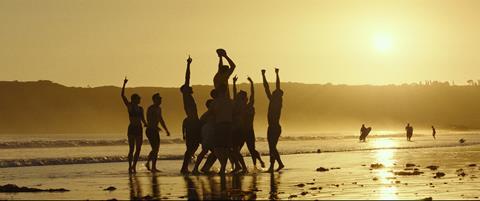
JOSEPH KOSINSKI: “When I started working on this, a lot of people came up to me and said, ‘Is there going to be a beach scene?’ A beach volleyball scene. After about the tenth person said that, I was like, ‘I’ve got to take this seriously,’ because a lot of people brought it up as the very first thing they wanted to know about the film. So, we put that challenge to our writer Ehren Kruger, who was working on the script at that point.
“If we put the scene in, how do we make it critical to the story? How do we tell a story through the sequence like we do with every single action scene? Ehren came up with this notion of dogfight football, which is offence and defence at the same time, two footballs. The chaos of it was something we wanted to embrace because it is a foreshadowing of what happens at the end, when they end up in Coffin Corner with missiles and incoming enemy aircraft.
“We played around with the placement of the scene in the film and found putting it after the Iceman scene gave you this lift that you needed to counteract the emotional heaviness of that. It served structurally as a kind of rebound, but also got us back on story, to what Maverick’s doing — preparing these pilots for a mission but also connecting with Penny. Beyond that, the first film is seen as this icon of male beauty, so what’s my version of that? How do I create that in 2022, in a way that feels appropriate? We had women involved, which was great, because we had two female pilots in the squadron.
“We shot it at Coronado beach, which is a private beach owned by the US Navy, at magic hour, over two days. The actors all put in a tremendous amount of work to look like what they look like on the day, which created this whole behind-the-scenes drama. When I showed up on the day, I thought to keep the teams separate, half were going to be shirtless, and half were going to be shirted. But as soon as I started assigning teams, every actor who was on the shirted team got a little upset that they had worked so hard on their physique and didn’t feel like they were going to be able to show it. So, after a couple of them came to me, pleading to be on the skins team, I said, ‘Okay, everyone’s on skins. Except Bob [played by Lewis Pullman]. You’ve got to keep your shirt on. That’s your character.’ He said, ‘Absolutely.’ But it was a fun day where we captured this bond that naturally existed between the actors.”
Maverick reconnects with Iceman
THE SCENE: Maverick is thinking of quitting Top Gun when he is summoned to see his old friend Iceman (Val Kilmer) at the latter’s home. There, Iceman, who has terminal cancer, tells him: the Navy needs Maverick.
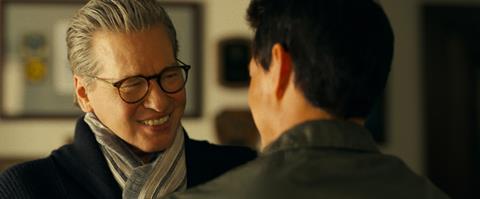
KOSINSKI: “Iceman, at least in Top Gun: Maverick, is kind of a mysterious character that is referred to by multiple people before we meet him. Obviously, people who have seen the first film know who Ice is. That character was the antagonist in the first film to Maverick, but at the end, they come to this great understanding. We had fun extrapolating that relationship over 36 years to imagine how far it’s come. Iceman in some ways represents the ideal Navy aviator. He won Top Gun. He went on to lead this incredible career where he’s now a four-star admiral, which is about as high as you can go in the Navy. Whereas Maverick continued to do what Maverick does, which is push the envelope, break a few rules, piss off superiors, but all in the service of pushing what he’s capable of and doing what he thinks is right. So Iceman has looked out for him.
“When we finally get to this scene where Iceman has ordered Maverick to come see him, we reveal he’s ill. That was a story point Val [whose speech remains impaired following throat cancer and a tracheotomy] offered up in our first meeting, to integrate that character into the film in an authentic way. That was an amazing, brave thing for Val to do. It opened this whole storyline, which serves Maverick’s story, because this is about a man who’s contemplating life and death and maybe the end of his career. In his conversation with Iceman, he’s confronted with it in a very real way. So, the scene is pivotal because he gets advice that only a good friend can give. Also, Maverick’s forced to confront the idea Iceman’s not always going to be there for him. As a scene and for the character, it’s such a critical moment in the film.
“Val struggles to be understood sometimes. The more you hang out with him, the easier it is to understand what he’s saying. On the day, we recorded his voice, but had to augment it and clean it up a bit so it was easier to understand to a first-time listener. We didn’t use any AI tech. I know that exists now, but we didn’t use it. Remember, we shot this in 2018. So, it’s a mix of his voice and a sound-a-like’s — although we tried to use as much of his as possible.”
Maverick and Rooster behind enemy lines
THE SCENE: Maverick and Rooster are shot down and forced to team up to get home safely.

KOSINSKI: “You’ve got two characters who have been at odds for the entire film. They’ve been sent into this high-pressure mission where the audience knows something will go wrong. Maverick gets shot down, saving Rooster’s life. Then Rooster saves Maverick’s life to only get shot down as well. So you’ve got this expression of love they’ve given each other by putting themselves in harm’s way to save each other’s life. Now they’re trapped together behind enemy lines, and the first thing Maverick does is yell at Rooster for saving his life. You’ve been through this tense sequence, and there’s this emotional release that comes with it. Also, this relationship feels like it’s a father and son.
“If the first film is the story of Maverick going from boy to man, this is Maverick going from man to father. And in that scene, you see him being a frustrated parent whose lessons are being turned back on him in a way he can’t really argue with, and can only admire, because the selflessness Rooster displays is why he was chosen for the mission in the first place.
“This part not only harkens back to the original and that amazing friendship and rapport that Maverick and Goose had, but the two of them being on the ground together was like Butch Cassidy and the Sundance Kid, as they try to get out of an impossible situation. That rapport is a totally different tone to their relationship up to that point. And it starts to feel more like the fun parts of the first film.
“The Top Gun aesthetic is San Diego and sunsets and that golden, endless magic hour. Because they were going into this mission, to make it feel even more dangerous, I wanted to take it as far out of that world as possible and invert the palette and look of the movie, so I loved the idea of switching to a snow-covered landscape for the third act.
“The body language and Rooster’s exasperation is something Miles brought on the day and makes it one of the biggest laughs when you watch it with an audience. Casting is everything when it comes to directing, and that’s where it pays off with two great actors doing their thing in the middle of a snow-covered field in Lake Tahoe. It’s probably my favourite part of the film.”
The canyon run
THE SCENE: Maverick takes to the air to show everyone how to fly the canyon run mission in the time limit he has stipulated.
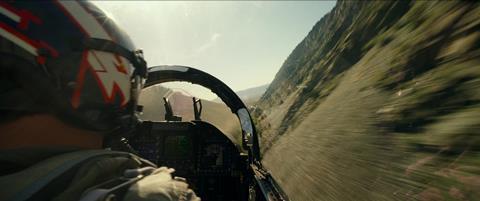
KOSINSKI: “Maverick has been teaching the recruits how the mission needs to be flown from his point of view. And before they’re able to put all the pieces together, Maverick’s grounded by Hamm’s Cyclone, because he doesn’t believe the mission can be flown as Maverick has designed it. So Maverick decides to basically steal a jet and demonstrate the course can be flown, in the time that it needs to be. And does it while Cyclone is instructing the students on his way of doing the mission. It’s a real thumb-in-the-eye moment to Cyclone, but a fist pump for the audience because it’s Maverick being Maverick, breaking the rules but proving his way is the right way.
“It is probably the most extreme thing we did. Even though we did a lot of extreme things, this was something we had to build up to in our skills as filmmakers but also in the level of trust we got from the Navy, because the Navy typically doesn’t allow training to go below 200 metres above the ground. Only in very special circumstances, they’ll allow certain pilots to go to 100 metres, but they would have to be highly skilled, because you’re travelling at 500-600 miles per hour and one mistake and you’re on the ground. There’s no room for error.
“Because Tom is an aviator, we wanted to push it further and see if we could get the sequence shot below 50 [metres]. And we did get permission from the very top of the Navy to have one pilot brought in to fly this sequence for us, a Blue Angel pilot, which means he flies for the Naval aerobatics team, with the call sign Walleye.
“Walleye and Tom did the sequence once. We looked at the footage. It looked amazing. We thought maybe we could even go lower. I think we shot it a second time that afternoon. After the plane landed, I looked at the footage and Walleye came up to me and said, ‘Did you get it?’ I said, yeah. And he said, ‘Good, because I’m never doing that again.’ We pushed it as far as it could be pushed. When you watch the sequence, you’ll see Tom is looking out the cockpit at his shadow on a mountain wall next to him. That’s not CGI. That’s all real.”

















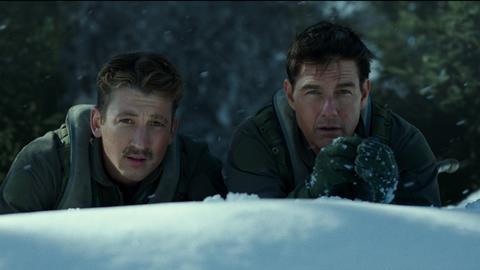






No comments yet